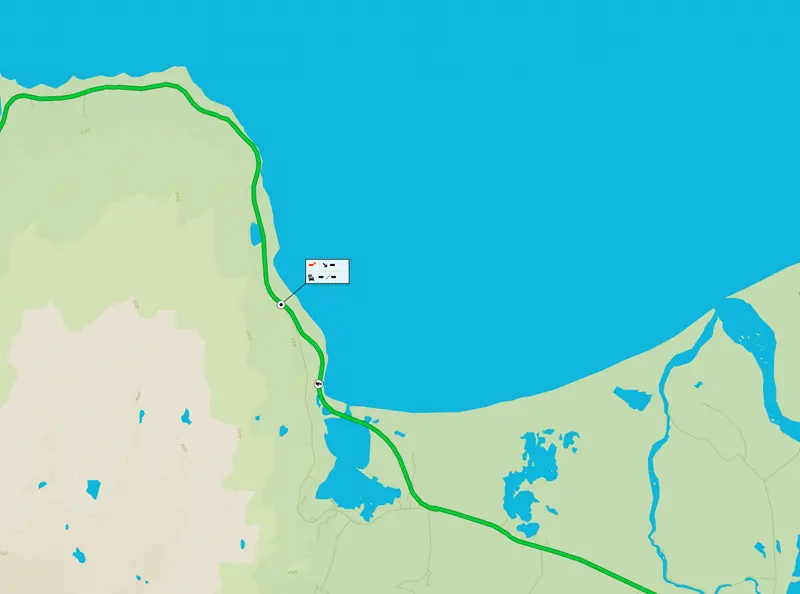8 ágúst 2025Recognised for final project and heading to Seattle on scholarship – Interview
Recognised for final project and heading to Seattle on scholarship – Interview
Annually, the Icelandic Concrete Association recognises a number of vocational, and/or college students that turn in a final project which either supports basic concrete research, or the use of concrete in Icelandic conditions. Ester María Eiríksdóttir, master carpenter and civil engineer newly graduated from the University of Reykjavík (HR), is among the students that received recognition for her work this last spring.

Ester María graduated as a civil engineer from Reykjavík University last spring.
Her final project, “Assessing connections in precast concrete elements,” was undertaken with financial backing from the IRCA’s research fund, and in accordance with a larger research project undertaken by the institution, whose main goal is to develop a precast bridge to be used in earthquake-prone areas.
Ester María is from Hofsós and graduated from Akureyri Comprehensive College (VMA) in 2021 with a Stúdentspróf diploma and carpentry certificate simultaneously. Following this Ester enrolled in Reykjavík University’s civil engineering program, where she graduated this past February.
Ester says that she possesses a strong desire to learn new things, and to learn them well. She enjoyed the positive, team-oriented spirit she experienced among her fellow civil engineering students at Reykjavík University: “Nothing beats solving problems with good people.”

Ester María and Ingi Sigurður Ólafsson were both recognised by the Icelandic Concrete Association. They pose with their certificates alongside the Association's chairman, Andri Jón Sigurbjörnsson.
Ester currently works at Stoð ehf., an engineering office in Sauðarkrókur, but will move to Seattle this coming fall for to attend a graduate program in civil engineering at the University of Washington, U.W., where she will, among other things, participate in a collaborative project with emphasis on earthquake-resistant design. Ester doesn’t believe she’s through with bridge design for good, but rather wants to experience all the various fields within civil engineering.
The opportunity to study in the United States was made available to her through the University of Washington’s Valle Scholarship, a scholarship awarded to promising incoming graduate students in Civil and Environmental Engineering or Built Environments, available to individuals based in the U.S., the Nordic countries and Baltic states.
“One of my project advisors, Ólafur Sveinn Haraldsson [director of the IRCA’s Research Division] had previously attended U.W. through the Valle Scholarship. He encouraged me to apply, which I went ahead and did. I received both admission into the University and the scholarship itself. The visa application process followed, which is still ongoing.”
Ester currently lives in her hometown of Hofsós. Although she’s lived in the larger towns of Akureyri and Reykjavík throughout her schooling the move to Seattle will no doubt be the biggest change of environment in her life. Ester, however, is ready for the experience and is looking forward to getting to know a new place, and undertaking new challenges.

Stress testing of specimen with experimental, "dry" connection. Steel units were used as clamps as a way to even out the applied force on the test specimen.

The test specimens ready for experiments. The specimen in the background has traditional U-loop connections, whilst the specimen in the foreground has experimental, "dry" connections.
As mentioned before, Ester’s final project was undertaken as a part of a larger IRCA research project on the design of precast concrete bridges for use in earthquake-prone areas. The goal of the project is to develop a method of bridge-building that contributes to an easier assembly process during construction operations, as well as the increased safety of construction workers. Precast bridges have seen real-world use, e.g. in the state of Texas in the USA, but nowhere has this method of construction been applied in a geologically active, earthquake-prone area such as Iceland. The project has received multiple grants from the IRCA research fund in the last few years. Students from both the University of Iceland and Reykjavík University have worked on related projects in co-operation with the IRCA.
“One of the challenges present in dealing with precast units centers around the connections between them. The connections used up until this point are “wet connections” which need to be moulded at the construction site. The goal of this project was to seek a design for a connection which could be just as strong, but more efficient in execution.”
Ester’s role consisted of information gathering, test-specimen connection design, load-bearing calculations, as well as construction of test specimens and subsequent experiments, including measuring the connections’ load-bearing capacity through the use of a hydraulic press.
The experimental test-specimen design was a “dry connection,” which would provide construction workers the opportunity to precast the concrete instead of needing to mould at the construction site. The connection units were connected together with steel channels, bolted together to create a unified connection. The test results gathered at the project’s end conduced that, with continued research, development and testing a “dry,” precast connection like the one built by Ester could withstand as much as traditional connections, and could replace them in Icelandic bridge-building.
The project spoke to Ester’s research capabilities, as well as to her practical background. She enjoyed being able to simultaneously employ her theoretical knowledge from her civil engineering studies, as well as her practical experience as a carpenter.
The IRCA’s research fund provided financial backing for the project, and, among other things, financed material costs for the construction of test specimens, and provided assistance with experiment execution. Ester would like to thank the IRCA:
„Það var gott að fá grunnhugmyndina í hendurnar og að hafa svo smá „pressu“ við gerð verkefnisins. Það var gaman að fá tækifæri til að vinna að alvöru hagnýtu verkefni, hvort sem mín hugmynd verður einhvern tímann nýtt eða ekki, sem og að hafa verið partur af nýsköpun og leit að betri lausnum.“
“It was good to receive the core idea directly, and to be “pressured” a bit in finishing the project. It was also enjoyable to get the opportunity to work on a truly beneficial project, irrespective of whether or not my designs will end up being used. It’s always great to be a part of innovation, and to strive for better solutions.”










